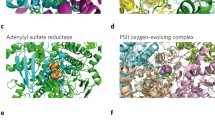Abstract
It is generally considered1 that sulphur reduction was one of the earliest forms of microbial respiration, because the known microorganisms that are most closely related to the last common ancestor of modern life are primarily anaerobic, sulphur-reducing hyperthermophiles2,3,4. However, geochemical evidence indicates that Fe(III) is more likely than sulphur to have been the first external electron acceptor of global significance in microbial metabolism5,6,7. Here we show that Archaea and Bacteria that are most closely related to the last common ancestor can reduce Fe(III) to Fe(II) and conserve energy to support growth from this respiration. Surprisingly, even Thermotoga maritima, previously considered to have only a fermentative metabolism, could grow as a respiratory organism when Fe(III) was provided as an electron acceptor. These results provide microbiological evidence that Fe(III) reduction could have been an important process on early Earth and suggest that microorganisms might contribute to Fe(III) reduction in modern hot biospheres. Furthermore, our discovery that hyperthermophiles that had previously been thought to require sulphur for cultivation can instead be grown without the production of toxic and corrosive sulphide, should aid biochemical investigations of these poorly understood organisms.



Similar content being viewed by others
References
Madigan, M. T., Martinko, J. M. & Parker, J. Biology of Microorganisms (Prentice Hall, Upper Saddle River, New Jersey, (1997)).
Pace, N. R. Origin of life — facing up to the physical setting. Cell 65, 531–533 (1991).
Adams, M. W. W. Enzymes and proteins from organisms that grow near and above 100 °C. Annu. Rev. Microbiol. 47, 627–658 (1993).
Stetter, K. O. Hyperthermophilic procaryotes. FEMS Microbiol. Rev. 18, 149–158 (1996).
de Duve, C. Vital Dust 1–362 (Basic Books, New York, (1995)).
Walker, J. C. G. Was the Archaean biosphere upside down? Nature 329, 710–712 (1987).
Cairns-Smith, A. G., Hall, A. J. & Russell, M. J. Mineral theories of the origin of life and an iron sulfide example. Orig. Life Evol. Biosph. 22, 161–180 (1992).
Walker, J. C. G. & Brimblecombe, P. Iron and sulfur in the pre-biologic ocean. Precambr. Res. 28, 205–222 (1985).
Kasting, J. F. Earth's early atmosphere. Science 259, 920–926 (1993).
De Ronde, C. E. J., De Wit, M. J. & Spooner, E. T. C. Early Archean (<3.2 Ga) Fe-oxide-rich, hydrothermal discharge vents in the Barberton greenstone belt, South Africa. Geol. Soc. Am. Bull. 106, 86–104 (1984).
Holm, N. G. Why are hydrothermal systems proposed as plausible environments for the origin of life? Origins Life Evol. Biosphere 22, 5–14 (1992).
Barns, S. M. & Nierzwicki-Bauer, S. A. Microbial diversity in ocean, surface, and subsurface environments. Rev. Mineral. 35, 35–79 (1997).
Lonergan, D. J. et al. Phylogenetic analysis of dissimilatory Fe(III)-reducing bacteria. J. Bacteriol. 178, 2402–2408 (1996).
Lovley, D. R., Coates, J. D., Saffarini, D. A. & Lonergan, D. J. in Iron and Related Transition Metals in Microbial Metabolism (eds Winkelman, G. & Carrano, C. J.) 187–215 (Harwood, Switzerland, (1997)).
Boone, D. R. et al. Bacillus infernus sp. nov., an Fe(III)- and Mn(IV)-reducing anaerobe from the deep terrestrial subsurface. Int. J. Sys. Bacteriol. 45, 441–448 (1995).
Slobodkin, A., Reysenbach, A.-, Strutz, N., Dreier, M. & Wiegel, J. Thermoterrabacterium ferrireducens gen. nov., sp. nov., a thermophilic anaerobic dissimilatory Fe(III)-reducing bacterium from a continental hot spring. Int. J. System. Bacteriol. 47, 541–547 (1997).
Greene, A. C., Patel, B. K. C. & Sheehy, A. J. Deferribacter thermophilus gen. nov., sp. nov., a novel thermophilic manganese- and iron-reducing bacterium isolated from a petroleum reservoir. Int. J. System. Bacteriol. 47, 505–509 (1997).
Liu, S. V. et al. Thermophilic Fe(III)-reducing bacteria from the deep subsurface: the evolutionary implications. Science 277, 1106–1109 (1997).
Lovley, D. R., Stolz, J. F., Nord, G. L. & Phillips, E. J. P. Anaerobic production of magnetite by a dissimilatory iron-reducing microorganism. Nature 330, 252–254 (1987).
Lovley, D. R. in Iron Biominerals (eds Frankel, R. B. & Blakemore, R. P.) 151–166 (Plenum, New York, (1990)).
McKay, D. S. et al. Search for past life on Mars: possible relic biogenic activity in Martian meteorite ALH84001. Science 273, 924–930 (1996).
Gold, T. The deep, hot biosphere. Proc. Natl Acad. Sci. USA 89, 6045–6049 (1992).
Huber, R. et al. Thermotoga maritima sp. nov. represents a new genus of unique extremely thermophilic eubacteria growing up to 90 °C. Arch. Microbiol. 144, 324–333 (1986).
Ravot, G. et al. Thiosulfate reduction, an important physiological feature shared by members of the order Thermotogales. Appl. Environ. Microbiol. 61, 2053–2055 (1995).
Childers, S., Vargas, M. & Noll, K. M. Improved methods for cultivation of the extremely thermophilic bacterium Thermotoga neapolitana. Appl. Environ. Microbiol. 58, 3949–3953 (1992).
Lovley, D. R. & Phillips, E. J. P. Organic matter mineralization with reduction of ferric iron in anaerobic sediments. Appl. Environ. Microbiol. 51, 683–689 (1986).
Hobbie, J. E., Daley, R. J. & Jasper, S. Use of Nuclepore filters for counting bacteria by fluorescence microscopy. Appl. Environ. Microbiol. 33, 1225–1228 (1977).
Acknowledgements
This work was supported by a grant from the LExEN program of the NSF.
Author information
Authors and Affiliations
Corresponding author
Rights and permissions
About this article
Cite this article
Vargas, M., Kashefi, K., Blunt-Harris, E. et al. Microbiological evidence for Fe(III) reduction on early Earth. Nature 395, 65–67 (1998). https://doi.org/10.1038/25720
Received:
Accepted:
Issue Date:
DOI: https://doi.org/10.1038/25720
- Springer Nature Limited
This article is cited by
-
Microbial synthesis of Prussian blue for potentiating checkpoint blockade immunotherapy
Nature Communications (2023)
-
Uniquely low stable iron isotopic signatures in deep marine sediments caused by Rayleigh distillation
Scientific Reports (2023)
-
A review on microbial fuel cell and green energy
Ionics (2023)
-
Electromicrobiology: the ecophysiology of phylogenetically diverse electroactive microorganisms
Nature Reviews Microbiology (2022)
-
Comparative insights into genome signatures of ferric iron oxide- and anode-stimulated Desulfuromonas spp. strains
BMC Genomics (2021)





